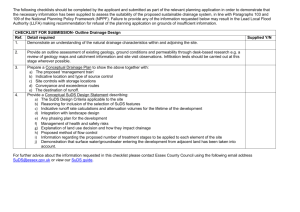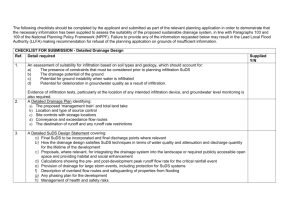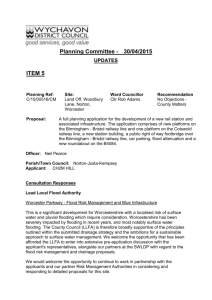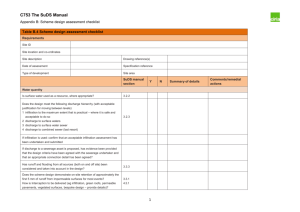to - Airey & Coles
advertisement
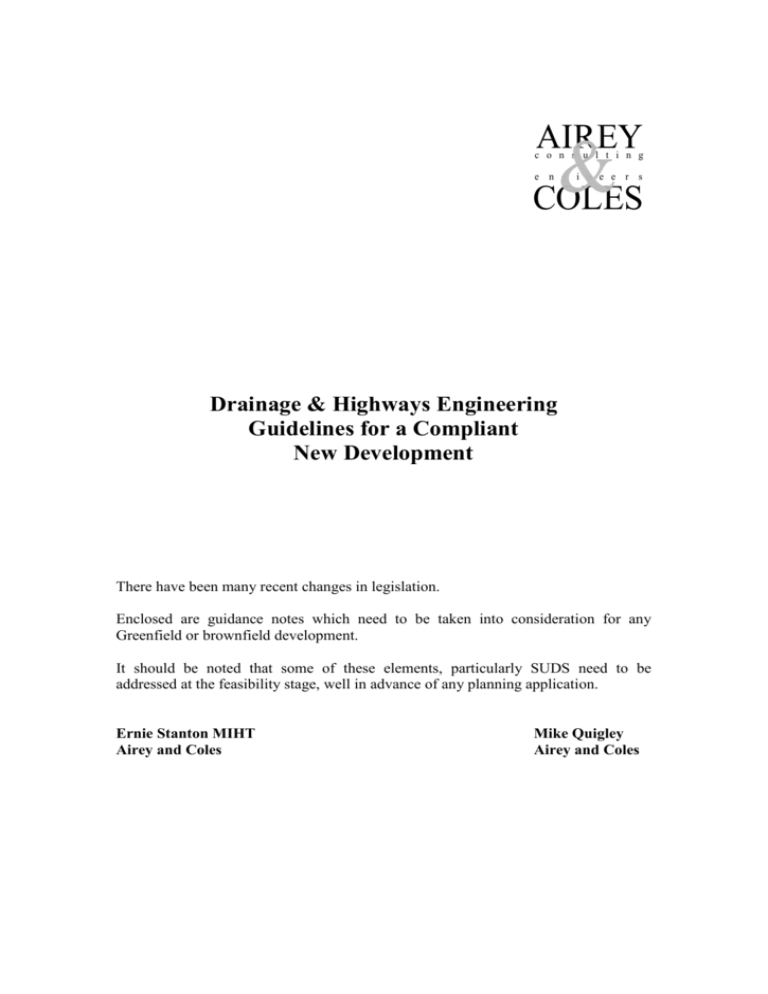
AIREY c o n s u l t i n g e n g i n e e r s COLES Drainage & Highways Engineering Guidelines for a Compliant New Development There have been many recent changes in legislation. Enclosed are guidance notes which need to be taken into consideration for any Greenfield or brownfield development. It should be noted that some of these elements, particularly SUDS need to be addressed at the feasibility stage, well in advance of any planning application. Ernie Stanton MIHT Airey and Coles Mike Quigley Airey and Coles Development / Flood Risk Assessment and Suds Introduction Changes in legislation regarding surface water drainage from green and brown field sites are now so onerous that a developer must employ a drainage engineer to assess the site for development, at the feasibility stage, and long before a planning application is considered. Planning Landowners/developers have a primary responsibility for safeguarding their land and other property against natural hazards such as flooding. Individual property owners and users are also responsible for managing the drainage of their land in such a way as to prevent, as far as reasonably practical, adverse impacts in neighbouring land, and on downstream land in flood risk areas. Those proposing development are responsible for: - Providing an assessment of: Whether any proposed development is likely to be affected by flooding from any source Whether it will increase flood risk elsewhere The measures proposed to deal with the effects and risks - Satisfying the LPA that any flood risks arising from the proposals will be successfully managed with minimal environmental effect. - Incorporating sustainable drainage systems and where necessary flood resilience measures. - Identifying opportunities to reduce flood risk, enhance biodiversity and amenity and seek collective solutions to managing flood risk. All of these matters affect the valve of land, the cost of developing it and the cost of its future maintenance and use. These should be considered as early as possible in preparing development proposals Proposers of development, which may be affected by or may add to flood risk should arrange pre-application discussions with the LPA and the EA. These discussions will identify the information that will be required by the LPA to reach a decision on the application when it is submitted. LPA’s are now strongly encouraged to request flood risk assessments. An appropriate FRA will be required to demonstrate how flood risk to the development itself and flood risk to others will be managed now and over the expected lifetime of the development. Planning applications for major developments (i.e. 10 dwellings or more) in flood zone 1 and developments in flood zone 2 & 3 should be accompanied by a FRA. Some site locations will now require assumed increases in peak flows of up to 20% for a given return period to allow for climate change. Others will require flood resilient buildings using water resistant materials for floors, walls and fixtures and the siting of electrical cables and appliances at high level. Surface water arising from a development site should as far as possible be managed in a sustainable manner to minimize the surface water arising from the undeveloped site while reducing the flood risk to the site itself and elsewhere. This should be demonstrated as part of the FRA. Suds The new interim Code of Practice for SUDS is to encourage the implementation of SUDS in new and existing developments. The aim of SUDS is to improve the sustainable management of water on the site by: 1. 2. 3. 4. 5. 6. Reducing peak flows to watercourses or sewers. Reducing volumes and frequency of water flowing directly to watercourses or sewers. Improving water quality by removing pollutants. Reducing potable water demand by rainwater harvesting. Improving amenity through providing open space and habitat. Replicating natural drainage patterns. SUDS should be discussed by the design team at a very early stage in the project. Preferably feasibility stage. Ground and groundwater considerations need to be made – percolation testing to BRE 365 needs to be addressed at a very early stage and any soil contamination identified. Drainage impact assessment – Planners now require a Flood Risk Assessment. These can vary from simple drainage philosophies to watercourse modeling. Again this should be addressed at a very early stage. Capacity within local surface water sewer or implications of making a connection to a combined public sewer if no surface water sewers are present need to be established. If infiltration is not possible, SUDS may be used to restrict discharge from site to a positive system. Long term maintenance of SUDS needs to be identified to the Planners and the EA. The EA is a statutory consultee to the Planning Authority and advises on general drainage and flooding issues. Planning policies need to take into account Planning Guidance, i.e. PPG25 & PPS25 (draft). Information from EA floodplain maps and other documents on flood risk areas should be consulted. Drainage issues may make the site uneconomical to develop. In the development brief, an assessment should be made of run off characteristics and site constraints and appropriate SUDS mechanisms should be designed to cater for them. In the first instance, developers are to be encouraged to include proposals for SUDS in the details submitted in support of a Planning Application. Its implementation can then be secured by a simple planning condition. Sewers For Adoption 6th Edition Sewers for Adoption 6th Edition comes into official use on 1st May 2006. The main changes are summarised below: The new Interim Code of Practice for Sustainable Drainage Systems together with PPG25 & PPS25 (draft) and legislation for both the EA and SWW now put the onus very heavily onto the developer to demonstrate that they are able to adequately and effectively deal with surface water drainage on a site. This surface water must be dealt with in a sustainable fashion, thereby: i) ii) iii) iv) v) Reducing the risk of flooding by not increasing surface water run off; Reducing the risk of pollution in particular diffuse pollution; Increasing the recharge of groundwater; Reducing the risk to property from rising groundwater and Without causing physical damage to the beds and banks of watercourses. It is therefore of the upmost importance that an Airey & Coles Drainage Engineer is involved at the very early stages of a development, and together with the design team can develop the scheme ensuring that SUDS is implemented. References: PPE 25 (draft) Interim Code of Practice for Suds PPG 25 Sewers For Adoption 6th Edition Legal Agreements associated with site development Any new development on green or brown field sites, and possibly even extensions to existing developments, will inevitably require at least one Legal Agreement. Each agreement has its own complexities with respect to approvals, costs and programme implications and each can vary from authority to authority. It should be noted that some agreements can have a serious effect on the project programme and it must therefore be established at the scheme inception what legal agreements may be required. Section 106 – Town & Country Planning Act Any planning approval may require a S106 agreement, which covers “works” outside the boundary of the site. These works can comprise something physical such as road widening, traffic calming, new site access road, pedestrian/cycleway provision, traffic lights, pedestrian crossings etc or may simply be a financial contribution to say the education budget or the provision of an improved bus service. These agreements can be contentious and negotiations extensive which will delay the final signing. Three months is not an unusual period from the council deeming to grant planning approval until the signing of the agreement. It should be noted that the planning approval only becomes effective when the S106 is engrossed. The requirements of the S106 can have a significant effect on the project and the programme so should be read by all. Section 278 - Highways Act Most large-scale developments will require some form of works to be undertaken on the existing public highways, and this is probably the most common requirement of a Section 106 Agreement. In some cases a S106 & S278 can be combined in one agreement. (It should be noted that only the highway authority has the right to carry out any work on the public highway, so they will inevitably need to be contacted for consent to undertake any proposed works. See other sections.) A Section 278 agreement is required to cover major changes to the road layout such as road widening etc and grants the developer the right to undertake approved works. A full design has to be submitted to the highway authority for both a technical and safety audit. Once approved a request has to be submitted to the Highway Authority to prepare the legal agreement. This again can take several months and work cannot commence until the document is signed and engrossed, and the inspection fee paid and a bond set up. The inspection fee varies between authorities but is generally in the order of 5 or 6% of the value of the road works with a minimum of £2,000. The bond is for 100% of the value of the roadwork. On smaller projects a returnable cheque could be used in lieu of the bond. Upon substantial completion of the roadworks and the completion of any remedial works revealed by a joint inspection, the works are placed upon 12 months maintenance. The road remains the responsibility of the developer for this 12 months period after which it is handed over to the Highways Authority. A final safety audit may require changes to what had previously been approved; ad this will be financed by the developer. Section 38 Agreement ~ Highway Act Any development, which requires on-site roads to be adopted by the highway authority, will require a Section 38 Agreement. This may not apply to commercial or retail developments etc but will almost certainly apply to housing development where the highway authority have a strong interest in having roads adopted. The road design has to be approved by the Highway Authority after which a request has to be submitted for the legal agreement to be prepared. This process will take several months but work can “un-officially” commence providing the inspection fee and bond have been organised, and the inspector informed. The inspection fee is 5 to 6% of the value of the road works, as estimated by the Highways Authority, and the bond 100%. Without a legal agreement organising the bond is difficult so a cheque in lieu of a bond is sometimes accepted. As roadworks progress the value of the bond can be reduced as stages of completion are achieved. Section 50 Notice ~ New Roads & Street Works Act If the development requires any private apparatus such as drains, cables or pipes to be placed under the highway a formal approval is required, under section 50. An application needs to be submitted to highways including proof that the service authorities have been contacted and that the contractor has adequate insurance. There is a cost for each length of highway affected by proposals but approval can be almost immediate. Road Opening Permit ~ New Roads & Street Works Act In the absence of a S278 or S38 agreement the contractor will need a road opening permit before undertaking any excavation in the public highway. Roadworks General Only contractors approved by the Highway authority can undertake works on the Public Highway and all operations must be certified under NRSWA. Traffic Management The temporary closure of a road needs approval of the highway authority, with agreement needed on the form of traffic control and signage etc. A closure of less than 5 working days can normally be approved with a weeks notice. Longer closures will require 4 weeks notice. Public Footpaths/Rights Of Way Any footpaths or public rights of way across the site must be maintained, clear of obstructions. Temporary closures or diversions can be arranged but need about 28 days notice. Permanent closure or diversion can take many months or even years to achieve. Advanced Payment Code In connection with residential development if the L.A are not in receipt of an application for a Section 38 Agreement, this can trigger the APC (Advanced Payment Code). In this the developer has to pay to the L.A the full costs of the roadworks because he is not offering the roads for adoption. This money is held by the L.A in case any time in the future, the residents on the development approach the L.A to have roads adopted. The APC monies are then used to prove that the roads are to an adoptable standard or to bring the roads up to an adoptable standard. If such a request from the residents is not received the L.A will continue to retain the money. The only way to circumvent this is to market the development as being private and establishing a management company to maintain the roads etc. This must be agreed with the highway authority at a very early stage. Environment Agency Consents The Environment Agency needs to be consulted with respect to surface water disposal, the use of petrol interceptors and any works which will affect existing watercourses. There is now a requirement that the principles of Sustainable Urban Drainage Systems (SUDS) be applied to all developments. The Environment Agency will need to be consulted on their requirements and will need to approve the proposed drainage scheme. This can be a relatively short process. Any works associated with an existing water course may require a “Consent to Discharge” and/or a “Consent to Works in the River”. Both can take up to 4 months for approval. Section 104 Agreements - Water Industry Act Any new sewers associated with a development can be offered to a drainage authority for adoption under a S104 Agreement. This requires a full design to be submitted for approval including layout, sections and calculations. A new foul water sewer must connect to an existing adopted sewer. The surface water sewer must connect to an existing adopted sewer or some other approved outfall. When the drainage authority approves the proposals a request needs to be made to progress a legal agreement. This agreement can take several months before it is finalised by generally a “unofficial” start will be tolerated providing the inspection fee, of about 5 or 6% is paid and a bond is set up or cheque deposited to the value of 10% of the works. The inspector must be notified so that inspections can be undertaken. Section 102 Agreement - Water Industrys Act Any sewer already constructed without there being an agreement with the drainage authority, can be adopted retrospectively under a S102 Agreement. Design details etc must be submitted together with a CCTV Survey. Section 185 Agreement - Water Industrys Act Any existing public sewer which crosses the site of development and which needs to be moved can be diverted under a Section 185 Agreement. Costs etc as above. All the above information is provided only as a general guide to the various legal agreements pertaining to site development and Airey and Coles accept no liability for any errors or omissions. In any case of doubt legal advice should be sought or contact made with the appropriate authority Bre 365 ~ Soakaway Percolation Testing Soil Infiltration Characteristics The method of determination must give representative results for the proposed site of the soakaway. This is achieved by: 1. Excavating a trial pit of sufficient size to represent a section of the design soakaway. 2. Filling the pit several times in quick succession whilst monitoring the rate of seepage to represent soil moisture conditions typical of the site when the soakaway becomes operative. 3. Examining site data to ensure that variations in soil conditions, areas of filled land, preferential under-ground seepage routes, variations in the level of groundwater, and any geotechnical and geological factors likely to affect the long-term percolation and stability of the area surrounding the soakaway have been assessed. Groundwater should not rise to the level of the base of the soakaway during annual variations in the water table. Local building control and/or planning authorities should advise where fluctuations in groundwater level may cause a problem in the long-term for any proposed depth of excavation. Soil Infiltration Rate Excavate a soakage trial pit 1 to 1.5m below the anticipated invert level of the drain discharging to the soakaway. Overall depths of excavation will be typically 2.5 to 3.0m. The trial pit should be as narrow as possible. The use of a 300mm bucket on the excavator is recommended, and 2 to 3m long.. It should have vertical sides trimmed square (if necessary for stability, it should be filled with granular material fill with a full-height, perforated, vertical observation tube positioned in the pit so that water levels can be monitored with a dip tape). It should be possible to construct a suitably dimensioned pit with a backhoe loader or mini-excavator. Narrow, short pits use less water for the soakage tests but may be more difficult to trim and clean prior to testing. Measure the pit carefully before trials. For safety reasons do not enter the pit. A lot of water will used to determine the soil infiltration rate so a water bowser needs to be used. The inflow should be rapid so that the pit can be filled to within 1m of ground level in a short time. Take care that the inflow does not cause the walls of the pit to collapse. Fill the pit to this level and allow it to drain three times to empty; each time recording the depth from ground level to the water level and time from filling, at intervals sufficiently close to clearly define water level versus time. The three fillings should be on the same or consecutive days. At no time should the pit be left unattended, especially if still containing water. If rock is encountered during excavation, at a level shallower than 1.5m deep, then the hole should be filled and testing in that vicinity abandoned. If rock is encountered at a level between 2 to 3m deep this hole should be similarly abandoned, but a second hole excavated in close proximity to the first but at a depth of 500mm above anticipated rock levels. Testing should be undertaken as above. Airey & Coles March 2006
